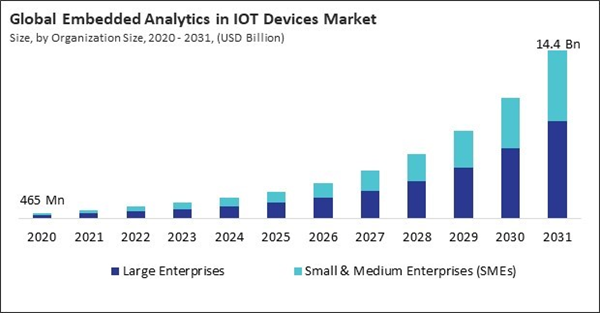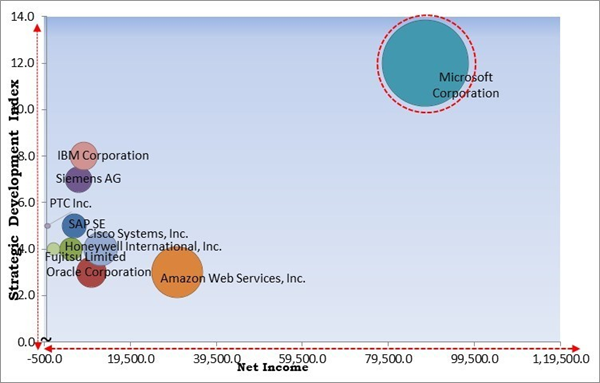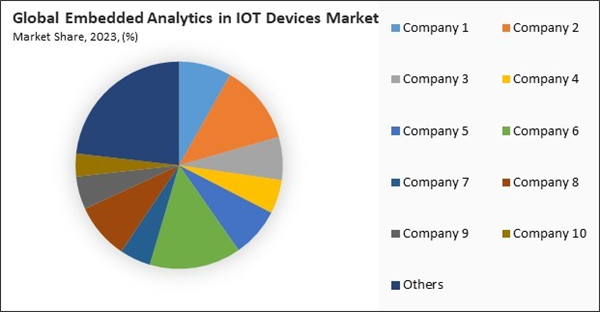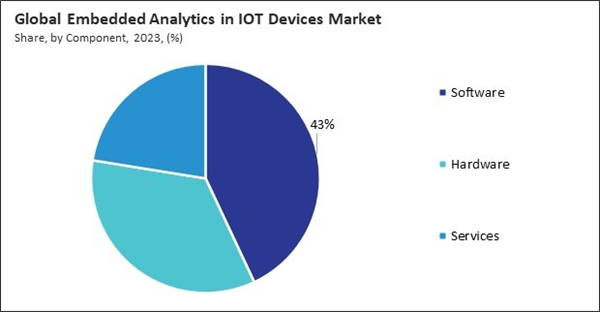The Global Embedded Analytics in IOT Devices Market size is expected to reach $14.4 billion by 2031, rising at a market growth of 35.1% CAGR during the forecast period.
Embedded analytics is a crucial component in this industry because it helps organizations make decisions based on data, which in turn improves efficiency and lowers operating costs. This is accomplished by offering real-time visibility into transportation operations. By analyzing data from connected vehicles and tracking systems, companies can gain insights into fuel consumption, driver behavior, and maintenance needs, enhancing performance and customer satisfaction. The transportation & logistics segment procured 14% revenue share in the embedded analytics in IOT devices market in 2023. The logistics industry has rapidly adopted IoT solutions to enhance fleet management, track shipments, and optimize routes.
The major strategies followed by the market participants are Partnership as the key developmental strategy to keep pace with the changing demands of end users. For instance, In June, 2024, Honeywell and PwC India have partnered to deliver comprehensive digital transformation solutions, combining PwC’s consulting expertise with Honeywell’s operational technology.
Their collaboration aims to enhance reliability, cybersecurity, and energy efficiency for businesses in the industrial and building sectors. Additionally, In April, 2024, Cisco Systems, Inc. and XL Axiata launched the IoT Connectivity+ product in Indonesia, featuring AI-powered anomaly detection and real-time analytics. This platform aims to simplify large-scale IoT management, enhance security, and support Indonesia's smart cities initiative with efficient connectivity solutions.
Additionally, in agriculture, IoT devices that incorporate AI algorithms can monitor soil conditions, weather patterns, and crop health, enabling producers to make data-driven decisions that enhance yield while minimizing resource consumption. These advancements transform industries by enabling smarter, more autonomous operations, driving the growing demand for embedded analytics. Thus, as these technologies mature, the demand for embedded analytics in IoT will grow exponentially.
The leading players in the market are competing with diverse innovative offerings to remain competitive in the market. The above illustration shows the percentage of revenue shared by some of the leading companies in the market. The leading players of the market are adopting various strategies in order to cater to demand coming from the different industries. The key developmental strategies in the market are Partnerships & Collaborations.
The competition in the market is intense, driven by the growing demand for real-time data insights across industries like healthcare, manufacturing, and smart homes. Key attributes include seamless integration with IoT platforms, scalability to handle massive data streams, and low-latency analytics processing. Solutions with enhanced security features, edge analytics capabilities, and AI-driven insights are gaining traction. The competitive edge lies in providing customizable, efficient, and secure analytics tools that can operate efficiently on resource-constrained IoT devices.
Embedded analytics is a crucial component in this industry because it helps organizations make decisions based on data, which in turn improves efficiency and lowers operating costs. This is accomplished by offering real-time visibility into transportation operations. By analyzing data from connected vehicles and tracking systems, companies can gain insights into fuel consumption, driver behavior, and maintenance needs, enhancing performance and customer satisfaction. The transportation & logistics segment procured 14% revenue share in the embedded analytics in IOT devices market in 2023. The logistics industry has rapidly adopted IoT solutions to enhance fleet management, track shipments, and optimize routes.
The major strategies followed by the market participants are Partnership as the key developmental strategy to keep pace with the changing demands of end users. For instance, In June, 2024, Honeywell and PwC India have partnered to deliver comprehensive digital transformation solutions, combining PwC’s consulting expertise with Honeywell’s operational technology.
Their collaboration aims to enhance reliability, cybersecurity, and energy efficiency for businesses in the industrial and building sectors. Additionally, In April, 2024, Cisco Systems, Inc. and XL Axiata launched the IoT Connectivity+ product in Indonesia, featuring AI-powered anomaly detection and real-time analytics. This platform aims to simplify large-scale IoT management, enhance security, and support Indonesia's smart cities initiative with efficient connectivity solutions.
Cardinal Matrix - Market Competition Analysis
Based on the Analysis presented in the Cardinal matrix; Apple, Inc. and Google, Inc. are the forerunners in the Embedded Analytics in IOT Devices Market. Companies such as IBM Corporation, Siemens AG and Honeywell International, Inc. are some of the key innovators in Embedded Analytics in IOT Devices Market. In July, 2024, Microsoft Corporation has entered into a partnership with Kontron Americas to provide Windows IoT licensing across North America. This collaboration allows Kontron to deliver comprehensive IoT solutions, improving security and support while addressing the changing demands of the IoT market.Market Growth Factors
The increase in IoT device adoption is not limited to individual households or manufacturing plants; it extends to sectors like healthcare, agriculture, and transportation. In healthcare, wearable devices that monitor patient vitals can analyze data on the device itself, alerting users or healthcare providers to any irregularities in real-time. This immediate feedback can be crucial for managing chronic conditions or responding to emergencies.Additionally, in agriculture, IoT devices that incorporate AI algorithms can monitor soil conditions, weather patterns, and crop health, enabling producers to make data-driven decisions that enhance yield while minimizing resource consumption. These advancements transform industries by enabling smarter, more autonomous operations, driving the growing demand for embedded analytics. Thus, as these technologies mature, the demand for embedded analytics in IoT will grow exponentially.
Market Restraining Factors
IoT ecosystems generate and collect vast amounts of sensitive data, often transmitted between devices, users, and cloud-based platforms. If not adequately managed, this data flow can expose systems to various security risks, such as data breaches, unauthorized access, and malware attacks. One of the primary concerns is the risk of data breaches. It is possible for hackers to get access to and steal data from the Internet of Things devices by exploiting weaknesses in these devices, such as obsolete firmware, insufficient encryption, or communication routes that are not effectively secured. Hence, the widespread adoption of embedded analytics in IOT devices is slowed as organizations prioritize security and privacy concerns over analytics capabilities.The leading players in the market are competing with diverse innovative offerings to remain competitive in the market. The above illustration shows the percentage of revenue shared by some of the leading companies in the market. The leading players of the market are adopting various strategies in order to cater to demand coming from the different industries. The key developmental strategies in the market are Partnerships & Collaborations.
Driving and Restraining Factors
Drivers
- Increased IoT device adoption
- Rising integration of artificial intelligence (AI) and machine learning (ML)
- Growing demand for predictive maintenance
Restraints
- Data privacy and security concerns
- Requirement of significant implementation costs
Opportunities
- Rapid growth of smart cities
- Interoperability and integration with cloud platforms
Challenges
- Substantial complexity in data integration
- Limited processing power of IoT devices
Component Outlook
Based on component, the market is classified into hardware, software, and services. The software segment procured 43% revenue share in the market in 2023. This segment encompasses the analytics platforms, applications, and tools necessary for processing and analyzing the data generated by IoT devices.Deployment Outlook
On the basis of deployment type, the market is divided into cloud, on-premises, and hybrid. The hybrid segment recorded 22% revenue share in the market in 2023. Organizational flexibility and scalability are enhanced by the hybrid approach, which integrates the advantages of both on-premises and cloud deployments.Vertical Outlook
By vertical, the market is segmented into manufacturing, healthcare, transportation & logistics, energy & utilities, retail, and others. The manufacturing segment witnessed 23% revenue share in the market in 2023. This growth is because of the industry's growing adoption of IoT technologies to enhance supply chain management, optimize production processes, and improve overall operational efficiency.Application Outlook
Based on application, the market is classified into predictive maintenance, asset management, operational efficiency, customer experience, security & monitoring, and others. The predictive maintenance segment acquired 24% revenue share in the market in 2023. Predictive maintenance enables organizations to analyze data from sensors in real-time to anticipate potential malfunctions before they occur, thereby monitoring the condition of their equipment.Organization Outlook
On the basis of organization size, the market is bifurcated into large enterprises and small & medium enterprises (SMEs). The small & medium enterprises (SMEs) segment procured 41% revenue share in the market in 2023. Numerous small and medium-sized enterprises (SMEs) are employing embedded analytics to optimize operations, improve consumer engagement, and make data-driven decisions that can result in increased efficiency and cost savings.Market Competition and Attributes
The competition in the market is intense, driven by the growing demand for real-time data insights across industries like healthcare, manufacturing, and smart homes. Key attributes include seamless integration with IoT platforms, scalability to handle massive data streams, and low-latency analytics processing. Solutions with enhanced security features, edge analytics capabilities, and AI-driven insights are gaining traction. The competitive edge lies in providing customizable, efficient, and secure analytics tools that can operate efficiently on resource-constrained IoT devices.
By Regional Analysis
Region-wise, the market is analyzed across North America, Europe, Asia Pacific, and LAMEA. The Europe segment recorded 32% revenue share in the market in 2023. European countries increasingly recognize the importance of IoT technologies in driving economic growth and improving operational efficiencies across various sectors.Recent Strategies Deployed in the Market
- Aug-2024: Oracle has expanded its Enterprise Communications Platform (ECP) by integrating AT&T’s IoT connectivity and network APIs. This expansion enables real-time IoT management for industry cloud applications, improving connectivity, reducing integration complexity, and driving innovative services in sectors such as utilities, healthcare, and public safety.
- Jul-2024: Microsoft Corporation has entered a partnership with Kontron Americas to provide Windows IoT licensing across North America. This collaboration allows Kontron to deliver comprehensive IoT solutions, improving security and support while addressing the changing demands of the IoT market.
- Jun-2024: Honeywell and PwC India have partnered to deliver comprehensive digital transformation solutions, combining PwC’s consulting expertise with Honeywell’s operational technology. Their collaboration aims to enhance reliability, cybersecurity, and energy efficiency for businesses in the industrial and building sectors.
- Apr-2024: SAP SE announced AI advancements in supply chain solutions, enhancing manufacturing productivity and efficiency. Real-time AI-driven insights will aid companies in optimizing decisions, streamlining product development, and increasing supply chain resilience amid ongoing global trade disruptions.
- Apr-2024: Cisco Systems, Inc. and XL Axiata launched the IoT Connectivity+ product in Indonesia, featuring AI-powered anomaly detection and real-time analytics. This platform aims to simplify large-scale IoT management, enhance security, and support Indonesia's smart cities initiative with efficient connectivity solutions.
- Jan-2024: IBM is expanding its Watson AI capabilities to enhance embedded analytics in IoT devices, transforming various industries. The partnership with ABB highlights real-time data analysis, which improves operational efficiency and patient care, fueling growth in the embedded analytics market. This strategic move underscores IBM's commitment to innovation and optimizing services through advanced AI solutions. For further details, visit the full article.
- Jan-2024: Microsoft and Cognite are expanding their partnership to integrate Cognite Data Fusion with Microsoft Fabric and Azure OpenAI Service, enhancing real-time data operations and AI capabilities in industrial IoT applications for improved decision-making and data management.
List of Key Companies Profiled
- IBM Corporation
- Microsoft Corporation
- SAP SE
- Oracle Corporation
- Cisco Systems, Inc.
- Amazon Web Services, Inc. (Amazon.com, Inc.)
- PTC Inc.
- Siemens AG
- Honeywell International, Inc.
- Fujitsu Limited
Market Report Segmentation
By Organization Size
- Large Enterprises
- Small & Medium Enterprises (SMEs)
By Component
- Cloud
- On-Premises
- Hybrid
By Deployment Type
- Geospatial Mapping
- Disaster Management
By Application
- Predictive Maintenance
- Asset Management
- Operational Efficiency
- Customer Experience
- Security & Monitoring
- Other Application
By Vertical
- Manufacturing
- Healthcare
- Transportation & Logistics
- Energy & Utilities
- Retail
- Other Vertical
By Geography
- North America
- US
- Canada
- Mexico
- Rest of North America
- Europe
- Germany
- UK
- France
- Russia
- Spain
- Italy
- Rest of Europe
- Asia Pacific
- China
- Japan
- India
- South Korea
- Singapore
- Malaysia
- Rest of Asia Pacific
- LAMEA
- Brazil
- Argentina
- UAE
- Saudi Arabia
- South Africa
- Nigeria
- Rest of LAMEA
Table of Contents
Chapter 1. Market Scope & Methodology
Chapter 2. Market at a Glance
Chapter 3. Market Overview
Chapter 4. Competition Analysis - Global
Chapter 5. Global Embedded Analytics in IOT Devices Market by Organization Size
Chapter 6. Global Embedded Analytics in IOT Devices Market by Component
Chapter 7. Global Embedded Analytics in IOT Devices Market by Deployment Type
Chapter 8. Global Embedded Analytics in IOT Devices Market by Application
Chapter 9. Global Embedded Analytics in IOT Devices Market by Vertical
Chapter 10. Global Embedded Analytics in IOT Devices Market by Region
Chapter 11. Company Profiles
Companies Mentioned
- IBM Corporation
- Microsoft Corporation
- SAP SE
- Oracle Corporation
- Cisco Systems, Inc.
- Amazon Web Services, Inc. (Amazon.com, Inc.)
- PTC Inc.
- Siemens AG
- Honeywell International, Inc.
- Fujitsu Limited
Methodology

LOADING...













